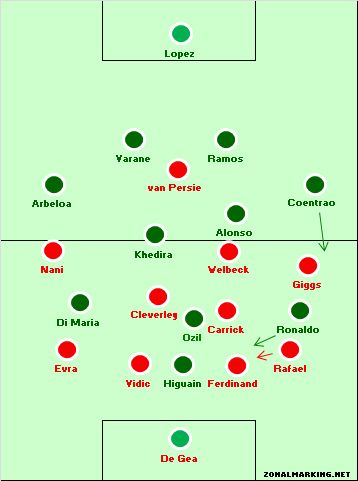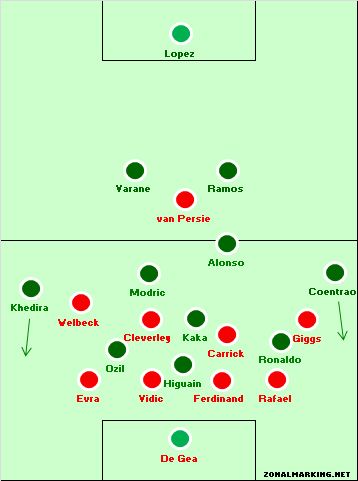本帖最后由 biang 于 2013-3-6 20:53 编辑
米兰2-0巴萨、巴萨1-3皇马、皇马2-1巴萨,凡此种种赛后一般媒体都免不了重提裁判漏判时,ZM还是坚守自己专业分析,不触及红线的。然而这一次ZM,却像宫砂痣破了的处女一改往日的害羞感,也不犹抱琵琶半遮面了
------------------------------------------------------
Manchester United 1-2 Real Madrid: red card allows Real to take control
曼联1-2皇马之战技术复盘分析:红牌力助皇马后来居上
March 6, 2013
 The starting line-ups 双方首发阵容
Manchester United’s starting strategy nullified Real Madrid’s main threats, but Jose Mourinho reacted quickly after United went down to ten.
Sir Alex Ferguson left out Wayne Rooney and Shinji Kagawa, favouring Nani and Ryan Giggs on the flanks. Tom Cleverley started in place of Phil Jones, while Jonny Evans dropped to the bench as Ferguson favoured the old-school Ferdinand-Vidic partnership.
Jose Mourinho named his expected side. Gonzalo Higuain was upfront rather than Karim Benzema, Raphael Varane continued at centre-back.
Sadly, we were denied a chance to see how the 11 v 11 game would play out – Real had looked impotent until Nani’s red card, and it would have been fascinating to see how they tried to break down United in the final half hour.
Ferguson selection 弗格森选择
The headline news from the pre-match teamsheets was the lack of Rooney. It was a surprise, but once you thought about the decision for a few moments, it wasn’t illogical. First, when Ferguson fielded Rooney, Kagawa and Danny Welbeck behind Robin van Persie in the first leg, Rooney was the only one of the trio that didn’t get a turn supporting the Dutchman – Kagawa started there, then Welbeck switched with him for the second half. Rooney was Ferguson’s third choice in the support striker role.
Second, Rooney’s defensive job at the Bernabeu was terrible – he switched off for Real’s three best chances, and therefore it was understandable Ferguson didn’t want to use him in a wide role, either. It was still a surprise decision, but it wasn’t unreasonable.
Instead, United had Giggs’ discipline on the right, and Nani on the left – which is essentially the ‘free’ position against Real Madrid, as Alvaro Arbeloa is their weakest player.
Ronaldo C罗
Real played their usual gameplan, with their expected XI, and were the side that needed to score. Therefore, this was all about how Ferguson would react to their style, and stopping two key players was his priority.
First, Rafael stuck tightly to Cristiano Ronaldo, tracking him inside as he made runs in very central positions. When he became a second centre-forward, he was picked up by United’s centre-backs, but when trying to find space to shoot from between the lines, Rafael was hot on his feels.
This meant Giggs had to track Fabio Coentrao, and he did a much better defensive job than Rooney at the Bernebeu, despite an early foul giving Ronaldo a chance to shoot from the resulting free-kick.
Alonso 阿隆索
But even more important was the defensive job Welbeck did on Xabi Alonso. He stuck tightly to the former Liverpool player at all times, preventing him getting any time on the ball, and forcing him into simple, negative passes out to the full-backs, rather than long diagonal balls to the wingers, or intelligent forward passes into central positions. Because of that, Real struggled to get into a good passing rhythm and their attacking quartet had little influence on the first half.
Instead, the freest player was Sami Khedira, who was sometimes pressed by Tom Cleverley, but not permanently because Cleverley also had to protect the back four, and therefore remain deep. Khedira knocked a good pass over the defence to Ronaldo for a half-chance, but Ferguson would have been entirely happy to give Khedira, rather than Alonso, Ronaldo, Angel Di Maria or Mesut Ozil time on the ball in midfield.
Counter-attacking threat 反击战威胁
United offered a threat on the break, too, with the attackers breaking past their direct opponent immediately when possession was won.
Again, Welbeck was the best example of this – he sped past Alonso (who, as the holding player, often had to let him go in order to close down the United player in possession) and combined nicely with Van Persie. The Dutchman’s movement towards play dragged one of the Real centre-backs out, and Welbeck could charge into some promising positions in the space created.
Giggs, too, offered a counter-attacking option on the break, and Nani did OK running at Arbeloa. Van Persie was quiet, but his movement was decent.
If there was one player you didn’t expect to be joining the charge, considering his defensive job against Ronaldo, it was Rafael. But he made two important forward runs – one was halted by Sergio Ramos’ challenge on the edge of the box towards the end of the first half (Cleverley and Michael Carrick immediately covered the right-back zone, with Nani also tucking in), and the second was in the build-up to United’s opener on 48 minutes.
SPs 曼联的定位球
United’s attacking set-pieces were always likely to be crucial – Real have often defended dead balls poorly this term, but are also excellent one the counter-attack in these situations.
United were relatively conservative at corners, pushing only four men into the box – but had the first half’s best chance when Nemanja Vidic hit the post. They were still troubled by the threat of the counter, however, as seen when Patrice Evra cynically hauled down Di Maria to prevent a quick break. Di Maria was later injured and replaced by Kaka, with Ozil going right.
10 v 11 十打十一
 The line-ups after Nani's red card, and Mourinho brought on Modric for Arbeloa, moving Khedira to right-back
Clearly, Nani’s red card – the merits of which can be debated elsewhere – completely changed the situation in the game. Not only were United down to ten men, they also had to drop Welbeck back from his support striker role into Nani’s left-sided midfield position, in order to preserve their second bank of four.
The result was that Alonso was now free, and within minutes he launched a fantastic long diagonal out to Ronaldo on the left, a more imaginative pass than he’d managed in the entire first half. United probably should have dropped Van Persie onto Alonso permanently, and left the centre-backs spare.
A more ambitious policy would have been to leave Arbeloa free at right-back, but this wasn’t a possibility because of Mourinho’s immediate substitution.
Modric 魔笛挺身而出
Mourinho always reacts quickly – to his own side’s goals, to opposition goals, and to red cards. Luka Modric replaced Arbeloa, with Khedira going to right-back.
This worked in two separate ways. First, Khedira offered great energy and overlapping threat from right-back, forcing United to keep defending that flank. Second, and much more importantly, Modric made the difference in the centre of the pitch. Real were knocked out of last season’s Champions League because they lacked a player who could play short, neat passes in the midfield zone, in the manner of Toni Kroos, and Modric’s signing allowed them to field a player like that in place of any of the three existing midfielders.
It hasn’t worked out for Modric in Madrid so far, but he’s often been a decent supersub in big games with his passing quality, bursts of energy to keep the pressing high, and dribbling ability (he beat an opponent four times in his half an hour on the pitch – no other player did so more than twice in the entire game), so there was every chance he could make an impact here. It was crucial that he went into Khedira’s role – Khedira had been the player being afforded space in the first half, remember – and from there he prompted some excellent passing sequences, and scored the equaliser with a brilliant long-range strike.
Real dominate 皇马从此统治了场面
From then, Real were in the ascendency, and the quartet of Modric, Alonso, Ozil and Kaka retained the ball superbly. Real’s strategy was great with a numerical superiority – they stretched the play with Khedira and Coentrao, yet didn’t resort to hopeful crosses into the box, which would have played into the hands of United’s two centre-backs.Instead, they concentrated on intricate passing moves, and got their reward quickly with Ronaldo’s winner.
With Real 2-1 up, and United needing two goals, the game turned again. Mourinho took off Ozil and brought on Pepe to play right-back, allowing Khedira back into midfield. Ferguson made three attacking changes – Rooney for Cleverley, Ashley Young for Welbeck, Antonio Valencia for Rafael – in the final 20 minutes.
United’s shape was ramshackle and risked conceding a goal on the break, but that wasn’t particularly relevant at this stage. Diego Lopez was forced into a couple of good saves, but more notable than United’s late strategy was Real’s complete lack of shape – they weren’t compact enough without the ball, with the defence sitting very deep, but the midfield strung out across the pitch, inviting pressure. Gonzalo Higuain went to the right, allowing Ronaldo to become a threat on the break, but it remained 2-1.
Conclusion 结论
At 11 v 11 Ferguson got the better of Mourinho – by using Welbeck to stop Alonso distributing the ball from midfield, United were rarely threatened by Real’s attacking quartet. The use of Giggs on the right was also broadly a success, and as Real pushed forward, United countered at speed, and were probably more of a goal threat. 当11人对11人时,弗格森的指挥优于魔力鸟 —— 列位请看,弗格森用维尔布克阻止了阿隆索从中场分球这一招,使得曼联几乎免受了皇马进攻端威胁。使用吉格斯在右路广泛活动也非常地成功,而且当皇马前进时,曼联就用反击速度来反制,所以曼联尽可能地制造了不止一个进球的威胁。
After Nani’s red card, credit must go to Mourinho. He reacted both immediately and intelligently, with Modric the perfect player to thrive on the extra room in midfield. Alonso also became a greater influence, and it quickly became clear United would be forced to cope with constant Real pressure, which eventually proved decisive. 纳尼吃牌染红下场后,得益的自然是魔力鸟一方,这是必须的(有便宜不占那才是大傻子),他的对策及其调整措施真可谓及时而又高智商,这时候使用魔笛这样完美大场面球员再往皇马中场加重力量“趁火打劫”再合适不过了。阿隆索的作用也变得较大分量了,而且这种随之而来的效应立马就显现出来了,曼联则不得不应付皇马持久而又绝大的前压围攻,这种变化最终则是决定性力量,不久的结果则无须赘述了
|

